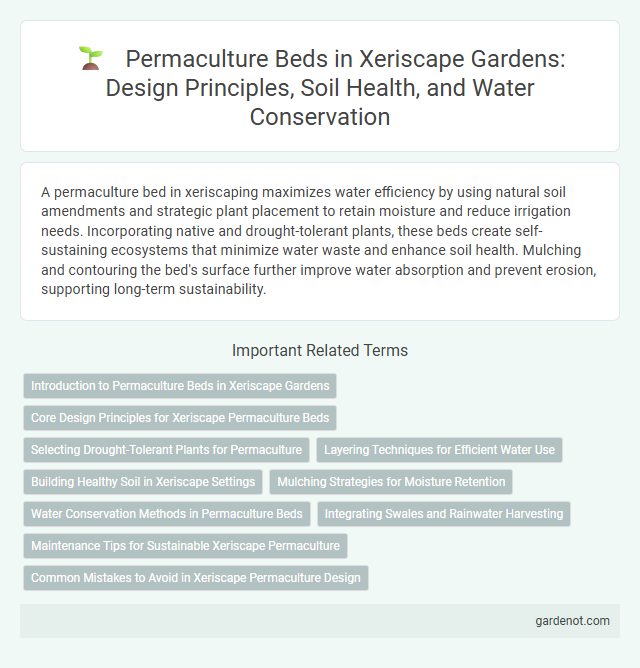A permaculture bed in xeriscaping maximizes water efficiency by using natural soil amendments and strategic plant placement to retain moisture and reduce irrigation needs. Incorporating native and drought-tolerant plants, these beds create self-sustaining ecosystems that minimize water waste and enhance soil health. Mulching and contouring the bed's surface further improve water absorption and prevent erosion, supporting long-term sustainability.
Introduction to Permaculture Beds in Xeriscape Gardens
Permaculture beds in xeriscape gardens integrate sustainable design principles to create self-sufficient, water-efficient planting areas. These beds use native, drought-tolerant plants organized in layers to maximize soil health, moisture retention, and biodiversity. Incorporating compost, mulch, and rainwater harvesting techniques enhances the resilience and productivity of xeriscape landscapes.
Core Design Principles for Xeriscape Permaculture Beds
Permaculture beds for xeriscaping emphasize water conservation, soil health, and plant synergy, incorporating principles such as mulching, contouring for rainwater capture, and selecting drought-tolerant native species. Layering plants to create microclimates reduces evaporation while enhancing biodiversity and resilience. Strategic placement of deep-rooted perennials alongside ground covers optimizes moisture retention and soil structure, ensuring sustainable water use and long-term garden productivity.
Selecting Drought-Tolerant Plants for Permaculture
Selecting drought-tolerant plants for a permaculture bed enhances water efficiency by utilizing species adapted to arid conditions, such as native succulents, lavender, and desert sage. These plants require minimal irrigation, promote soil health, and support local biodiversity, reducing maintenance and water usage. Incorporating deep-rooted perennials and nitrogen-fixing legumes further improves soil structure and nutrient cycling within the xeriscape design.
Layering Techniques for Efficient Water Use
Permaculture beds utilize layering techniques to maximize water retention and minimize evaporation, creating an efficient xeriscape system. Strategic placement of ground cover, mulch, and deep-rooted plants enhances soil moisture conservation by reducing runoff and promoting infiltration. Incorporating diverse plant species with varying root depths optimizes water use while improving soil health and resilience against drought.
Building Healthy Soil in Xeriscape Settings
Permaculture beds in xeriscape settings prioritize building healthy soil through techniques such as layering organic matter, using mulch to retain moisture, and incorporating diverse plant species to enhance microbial activity. These methods improve soil structure, increase water retention, and promote nutrient cycling crucial for drought-tolerant landscapes. Healthy soil development supports resilient xeriscape gardens by reducing the need for supplemental water and synthetic fertilizers.
Mulching Strategies for Moisture Retention
Permaculture beds in xeriscaping utilize mulching strategies to significantly enhance moisture retention, reducing the need for frequent irrigation. Organic mulches such as straw, wood chips, and compost create a protective layer that minimizes evaporation, moderates soil temperature, and supports beneficial microbial activity. Implementing thick, layered mulching in permaculture beds optimizes water conservation and promotes sustainable plant growth in arid environments.
Water Conservation Methods in Permaculture Beds
Permaculture beds employ strategic water conservation methods such as mulching, swales, and berms to enhance soil moisture retention and reduce irrigation needs. Deep-rooted perennial plants and organic matter improve water infiltration and minimize evaporation, creating resilient microclimates. These techniques optimize water usage, support plant health, and contribute to sustainable xeriscape gardening.
Integrating Swales and Rainwater Harvesting
Permaculture beds benefit significantly from integrating swales and rainwater harvesting, capturing and directing rainwater efficiently to enhance soil moisture and reduce erosion. Swales, strategically placed on contour lines, slow runoff and maximize water infiltration, supporting sustainable irrigation in xeriscape gardens. Combining these techniques improves water conservation, promoting resilient plant growth in arid environments.
Maintenance Tips for Sustainable Xeriscape Permaculture
Maintaining a xeriscape permaculture bed requires regular monitoring of soil moisture levels and mulching to preserve hydration and reduce weed growth. Incorporating native, drought-tolerant plants minimizes irrigation needs and supports local ecosystems. Pruning and composting organic matter enhance soil fertility, promoting long-term sustainability in arid landscapes.
Common Mistakes to Avoid in Xeriscape Permaculture Design
Overusing non-native plants disrupts local ecosystems and increases water demand in xeriscape permaculture beds. Neglecting soil health by not incorporating organic matter reduces water retention and plant vitality. Improper spacing leads to competition for resources, undermining the efficiency and sustainability of the design.
Permaculture bed Infographic

 gardenot.com
gardenot.com